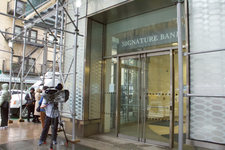
Back الأزمة المصرفية 2023 Arabic Банкаўскі крызіс (2023) Byelorussian Bankenkrise 2023 German Πτώχευση τραπεζών στις ΗΠΑ το 2023 Greek Quiebras bancarias de Estados Unidos de 2023 Spanish ورشکستگی ۲۰۲۳ بانکهای ایالات متحده Persian Faillites bancaires de 2023 aux États-Unis French Géarchéim airgeadais 2023 Irish קריסת הבנקים בארצות הברית (2023) HE 2023年のアメリカ合衆国における銀行破綻 Japanese
| This article is part of a series about the |
| 2023 United States banking crisis |
|---|
 |
The 2023 United States banking crisis was a series of bank failures and bankruptcies that took place in early 2023, with the United States federal government ultimately intervening in several ways. Over the course of five days in March 2023, three small-to-mid size U.S. banks failed, triggering a sharp decline in global bank stock prices and swift response by regulators to prevent potential global contagion. Silicon Valley Bank (SVB) failed when a bank run was triggered after it sold its Treasury bond portfolio at a large loss, causing depositor concerns about the bank's liquidity. The bonds had lost significant value as market interest rates rose after the bank had shifted its portfolio to longer-maturity bonds. The bank's clientele was primarily technology companies and wealthy individuals holding large deposits, but balances exceeding $250,000 were not insured by the Federal Deposit Insurance Corporation (FDIC). Silvergate Bank and Signature Bank, both with significant exposure to cryptocurrency, failed in the midst of turbulence in that market.
In response to the bank failures, the three major U.S. federal bank regulators announced in a joint communiqué that extraordinary measures would be taken to ensure that all deposits at Silicon Valley Bank and Signature Bank would be honored.[1] The Federal Reserve established a Bank Term Funding Program (BTFP) to offer loans of up to one year to eligible depository institutions pledging qualifying assets as collateral.[2][3]
To prevent the situation from affecting more banks, global industry regulators, including the Federal Reserve, the Bank of Canada, Bank of England, Bank of Japan, European Central Bank, and Swiss National Bank intervened to provide extraordinary liquidity.[4][5][6]
By March 16, large interbank flows of funds were occurring to shore up bank balance sheets and some analysts were talking of a possibly broader U.S. banking crisis.[7] The Federal Reserve discount window liquidity facility had experienced approximately $150 billion in borrowing from various banks by March 16.[8]
Soon after the bank run at SVB, depositors quickly began withdrawing cash from San Francisco-based First Republic Bank (FRB), which focused on private banking to wealthy clientele. Like SVB, FRB had substantial uninsured deposits exceeding $250,000; such deposits constituted 68% of the bank's total at year-end 2022, declining to 27% by the end of March, as $100 billion in uninsured deposits were withdrawn. Despite a $30 billion capital infusion from a group of major banks in March, FRB continued to destabilize and its stock price plummeted as the FDIC prepared to take it into receivership and find a buyer on April 29.[9][10] On May 1, the FDIC announced that First Republic had been closed and sold to JPMorgan Chase.[11][12]
- ^ "Joint Statement by Treasury, Federal Reserve, and FDIC". Federal Reserve. March 12, 2023. Archived from the original on March 12, 2023. Retrieved March 12, 2023.
- ^ "Federal Reserve Board announces it will make available additional funding to eligible depository institutions to help assure banks have the ability to meet the needs of all their depositors". Federal Reserve. March 12, 2023. Archived from the original on March 12, 2023. Retrieved March 12, 2023.
 This article incorporates text from this source, which is in the public domain.
This article incorporates text from this source, which is in the public domain.
- ^ Stein, Jeff; Lynch, David J.; Romm, Tony; Pager, Tyler (March 12, 2023). "U.S. says 'all' deposits at failed bank will be available Monday". The Washington Post. Archived from the original on March 12, 2023. Retrieved March 12, 2023.
- ^ Thompson, Mark (March 17, 2023). "Global banking crisis: What just happened?". CNN. Archived from the original on April 6, 2023. Retrieved March 20, 2023.
- ^ Choe, Stan; McDonald, Joe (March 20, 2023). "Stocks rise on Wall Street after bank deal, regulator moves". Los Angeles Times. Archived from the original on April 11, 2023. Retrieved March 20, 2023.
- ^ Henderson, Richard; Lee, Isabelle; Greifeld, Katherine (March 20, 2023). "Investors Say Banking Crisis Far From Over Even After UBS's Credit Suisse Deal". Bloomberg. Retrieved March 20, 2023.
- ^ Choi, Candace (March 16, 2023). "The Banking Crisis: A Timeline of Silicon Valley Bank's Collapse and Other Key Events : The latest on the fallout that followed and regulators' response". Wall Street Journal. Archived from the original on March 16, 2023. Retrieved March 17, 2023.
- ^ Cox, Jeff (March 16, 2023). "Banks take advantage of Fed crisis lending programs". CNBC. Archived from the original on March 17, 2023. Retrieved March 17, 2023.
- ^ Isidore, Chris (April 29, 2023). "What's next for troubled First Republic Bank". CNN. Retrieved April 30, 2023.
- ^ Son, Hugh (April 29, 2023). "Big banks including JPMorgan Chase, Bank of America asked for final bids on First Republic". CNBC. Retrieved April 30, 2023.
- ^ Farrell, Maureen; Smialek, Jeanna; Hirsch, Lauren (May 1, 2023). "First Republic Bank Is Seized by Regulators and Sold to JPMorgan Chase". The New York Times. Retrieved May 1, 2023.
- ^ "JPMorgan Chase Bank, National Association, Columbus, Ohio Assumes All the Deposits of First Republic Bank, San Francisco, California". FDIC. May 1, 2023. Retrieved May 1, 2023.